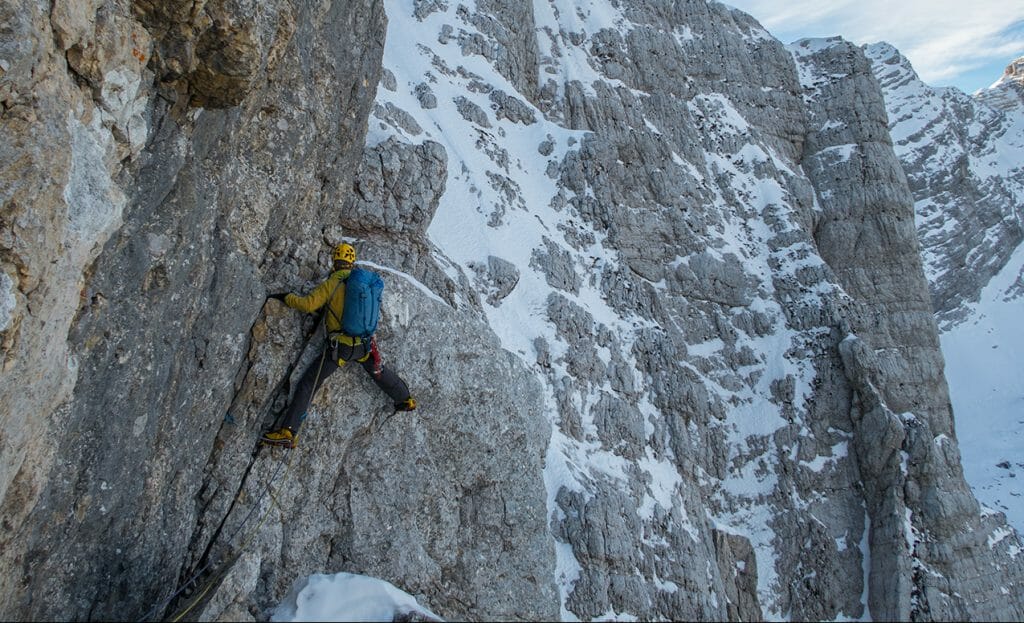Mental strength, the ability to think—and act—clearly and smartly in demanding and dangerous situations, is the single most difficult capacity to improve as a mountain athlete. The building blocks of mental strength may contain concrete knowledge of weather, snowpack, and navigation. But most of what makes a mentally strong climber, skier, or runner is not readily understandable. As concentration, calmness, confidence, and clarity of judgment are the hallmarks of the greats, it’s worth a closer study.
My Time in Slovenia
It was a fortunate accident that I studied in Slovenia, then a state of Yugoslavia, in 1988 and 1989. There I was introduced to alpinism—climbing technical rock, ice, and mixed routes in the mountains. The story is the basis of my book Beyond the Mountain, so I won’t retell it here. I continue to enjoy climbing in Slovenia often, particularly in the Julian Alps.
The Julian Alps are big for small mountains. Small because they reach their maximum altitude on the summit of Triglav, an unimpressive 2,863 meters (9,396 feet). Big because the walls start low and there is no easy access. Cable cars and lifts are nonexistent. It’s a long ways to the base of the routes, and from there it is a long ways again to the top.
Besides being big, the routes in the Julian Alps epitomize a type of alpinism we sometimes joke as being “not difficult, just dangerous.” The rock is often loose, and the routes moderately graded (it’s not uncommon for me to climb a 5.5 or 5.6 there). Why does this matter? Very early in my climbing (at 18 years old), I was baptized into that world of very long, easy routes on treacherous terrain climbed in all seasons. The focus of these ascents was not cranking hard moves, but moving safely, efficiently, and quickly because, well, the mountains are big and there is no cable car waiting for you at the top. How do you do this? One word: awareness. I call it “Fuzzy Awareness.”
Fuzzy Awareness
In the Fuzzy Awareness state I’m hyper-focused on climbing—and all that that means—but not focused in the laser-pointer kind of way required by, say, a hard sport climb or boulder problem where micro-positions are crucial.
Don’t hurry, you don’t have time to waste.
This attitude of awareness was a blessing in disguise because it came at the right time—for me—in my development as a climber. As I my climbing skills progressed through my 20s, I retained a learned ability to create this Fuzzy Awareness state. Though not perfect, my access to that state can be blocked by lack of practice, stress, expectations, and sometimes fatigue.
Fuzzy Awareness feels like having the center of your awareness floating one meter above and behind you. You see the hand- and footholds in front of you, but you also see the features out to the side—the dihedral, for example. And you keep track of where you’re going, where your last protection is, where your next protection will likely be. You’re scanning for fixed gear and paying attention to the possibility that spindrift may be starting to come down on top of you. These last points are crucial because, remember, the climbing is easy. The routefinding, managing poor rock, placing enough gear, not placing too much gear, belaying in the right spots, staying on-route, keeping the rope team in the safest available position relative to objective hazards—these are the skills and practices that not only help you climb the route, but keep you safe.
If you want to be a better alpinist or ski mountaineer or mountain runner, try practicing Fuzzy Awareness. And let me know if it works for you.
-by Steve House
Postscript: One alert Uphill Athlete reader forwarded us this scholarly article on Fuzzy Awareness for those who would like to dig deeper into this subject.

